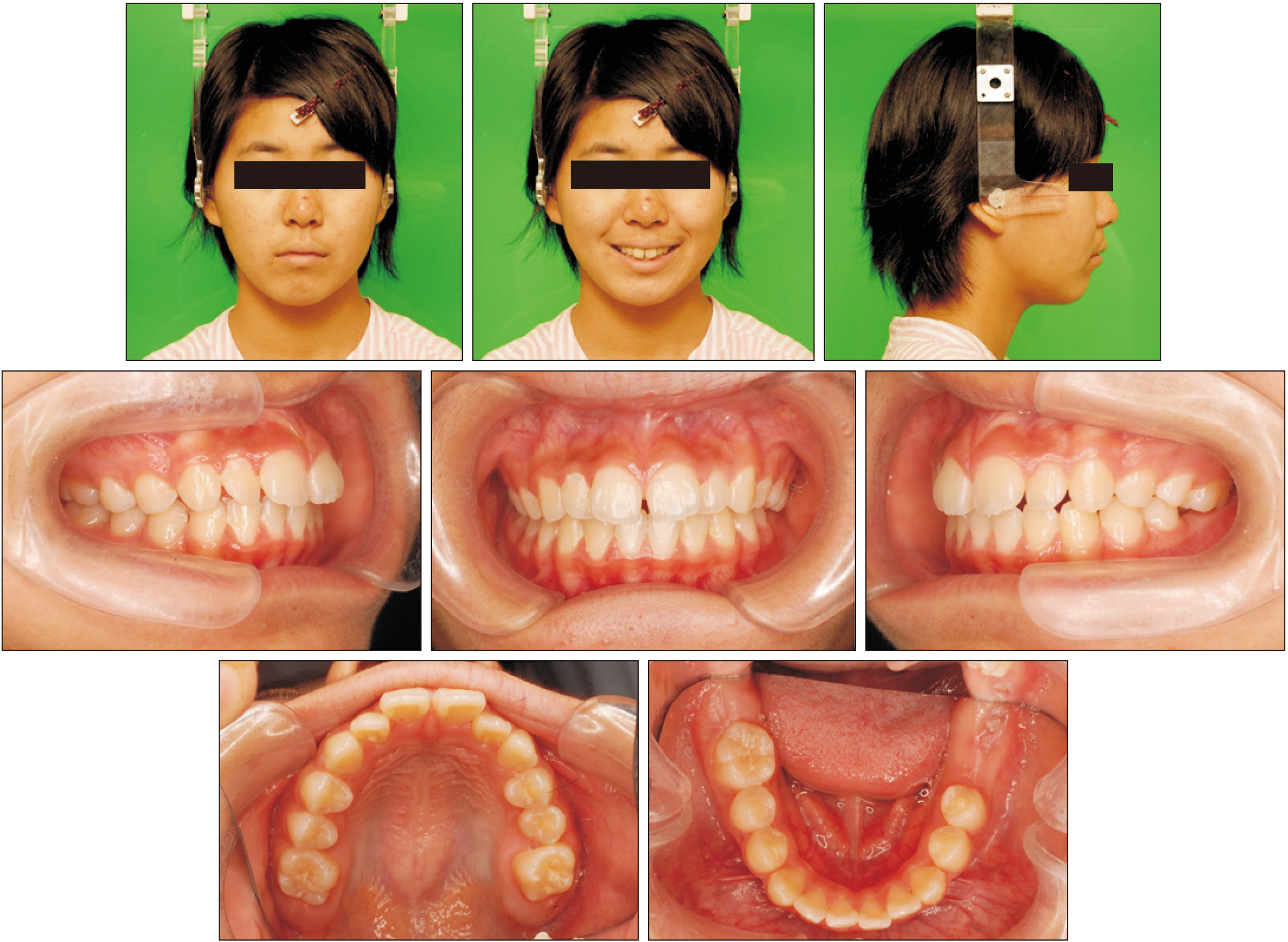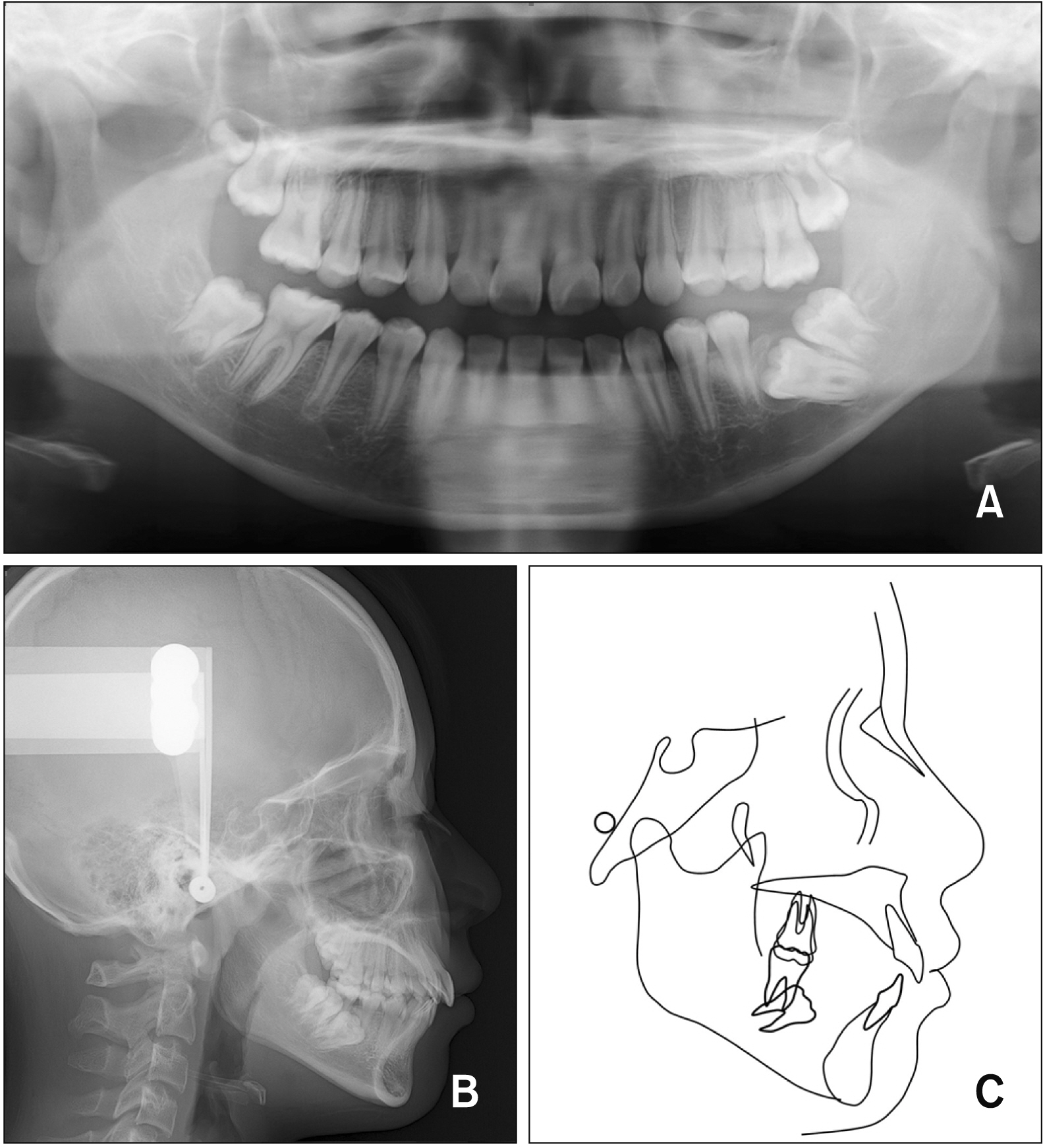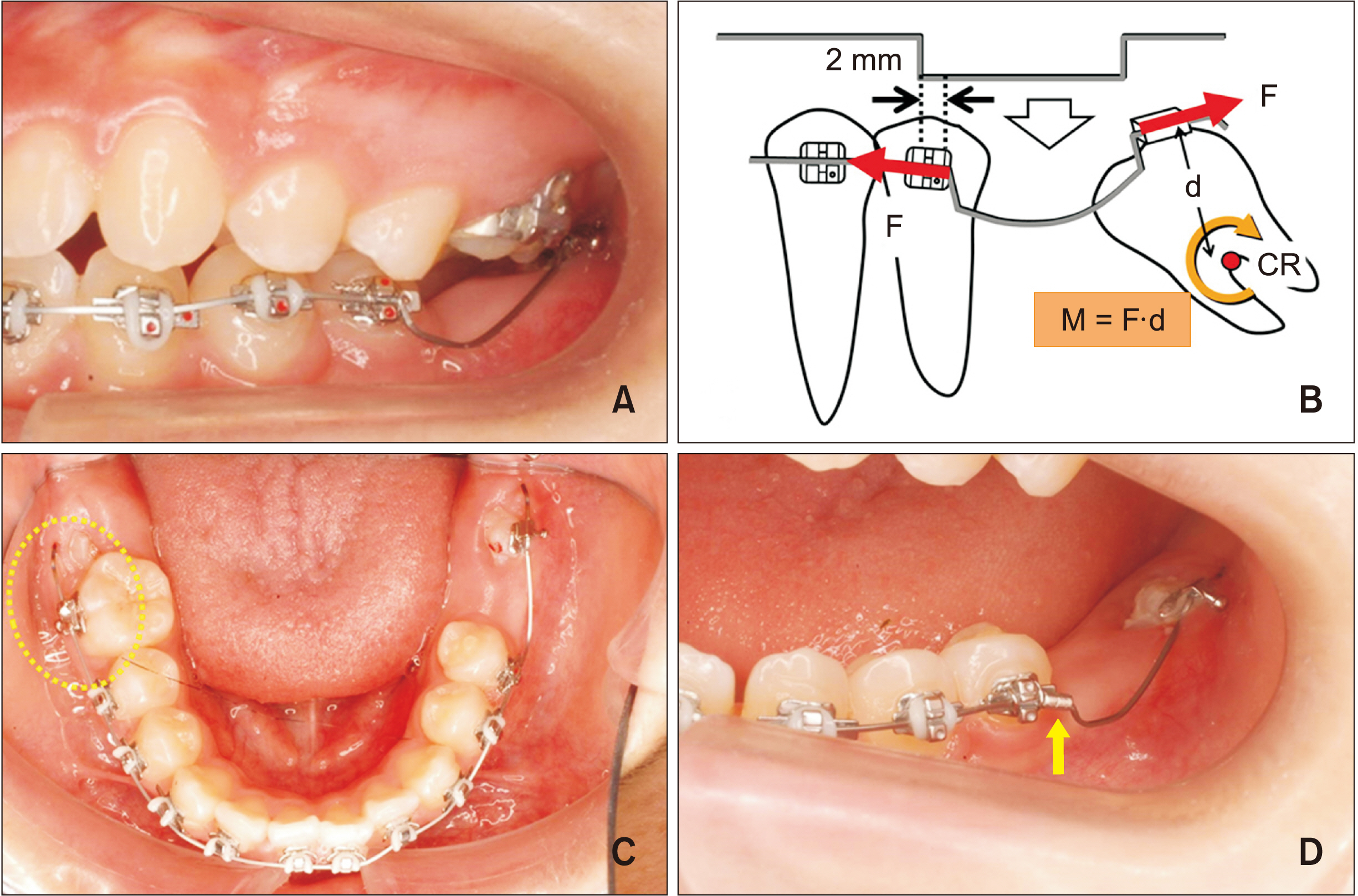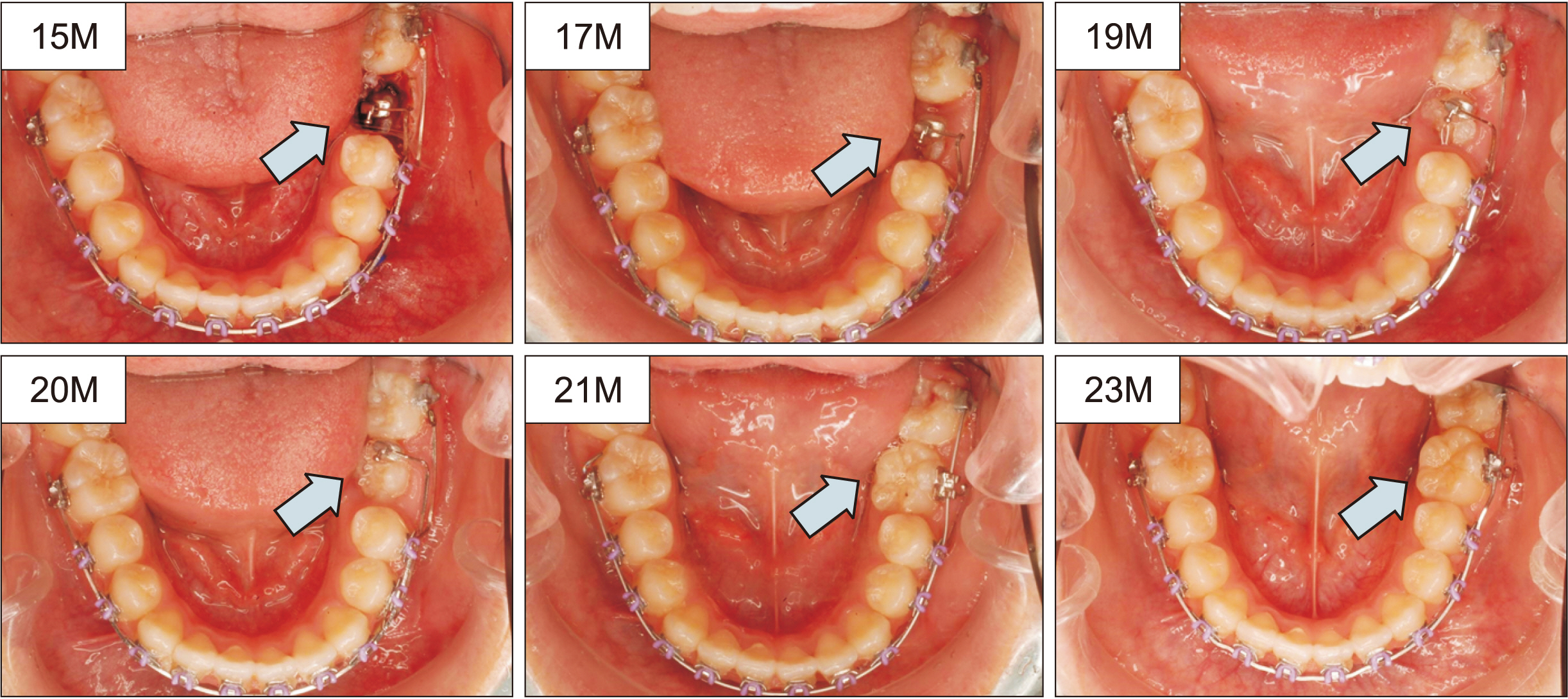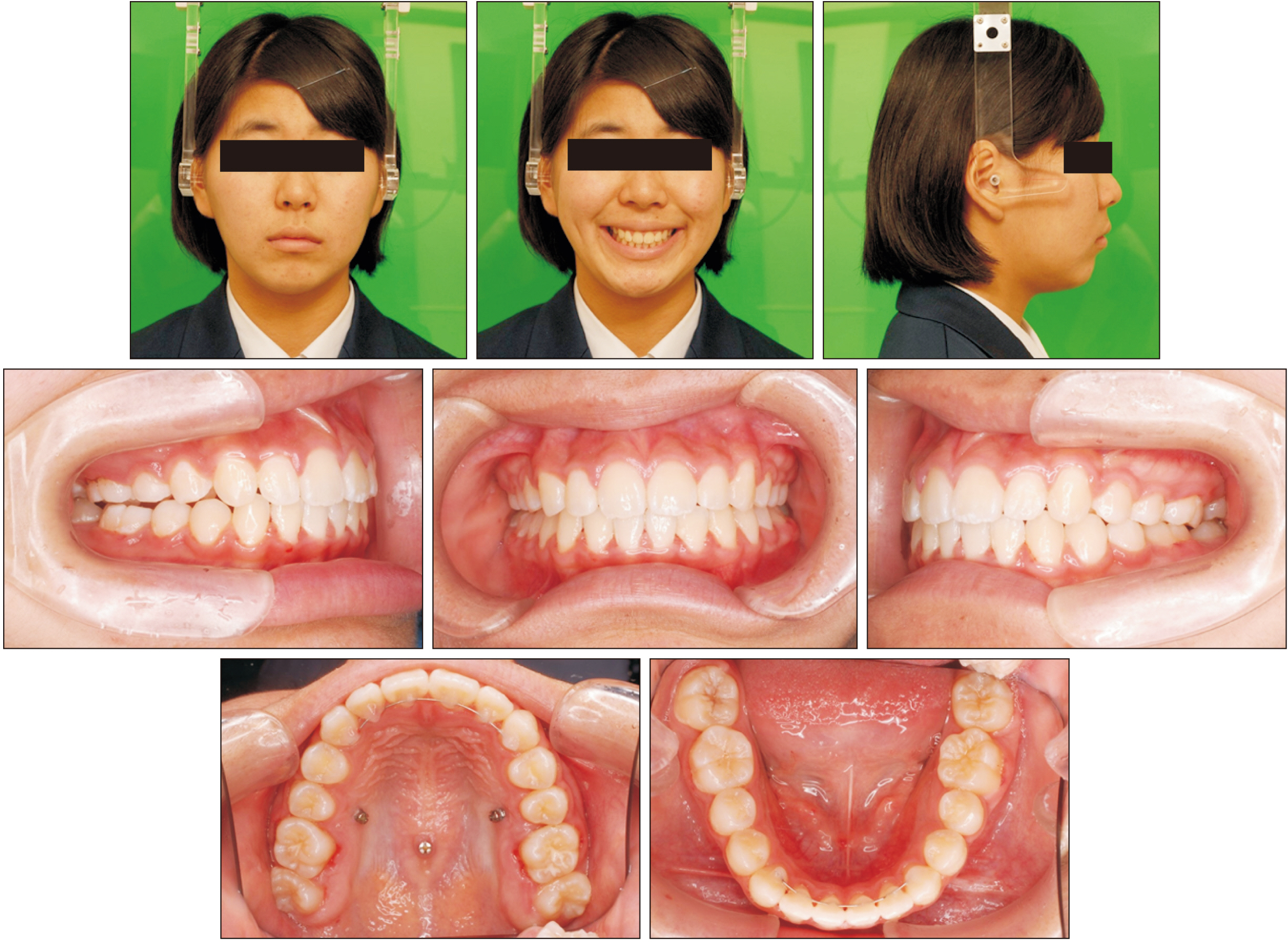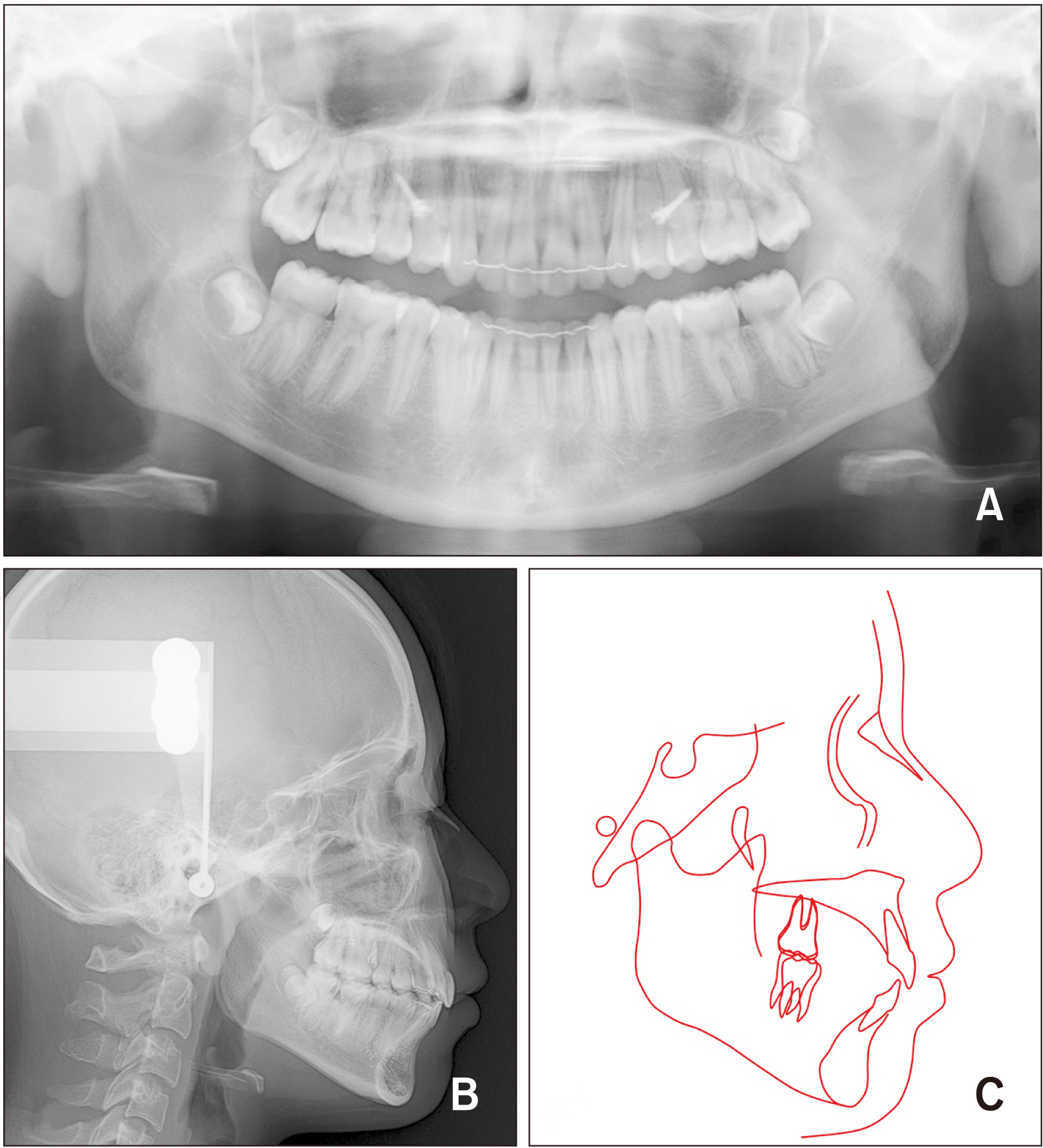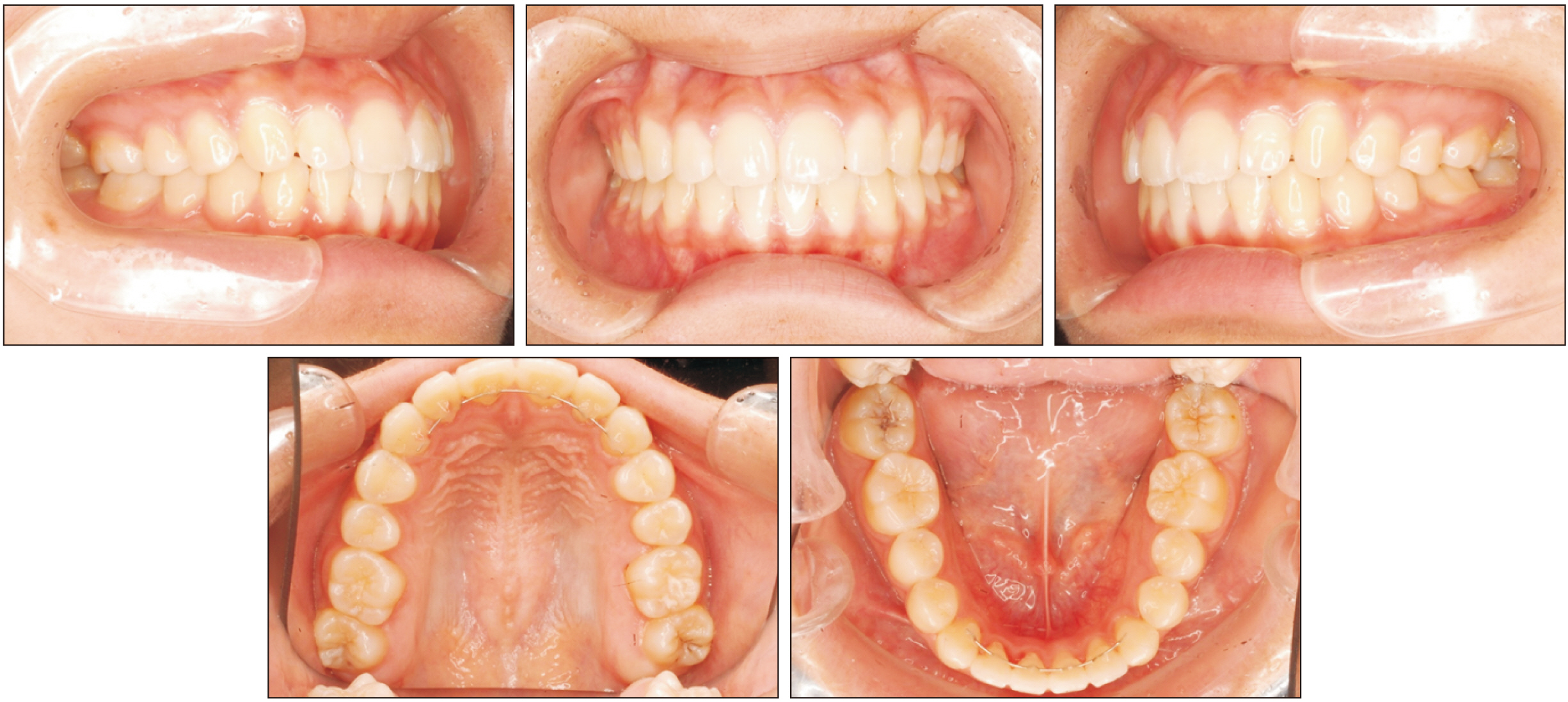Korean J Orthod.
2020 Jul;50(4):268-277. 10.4041/kjod.2020.50.4.268.
Biomechanical considerations for uprighting impacted mandibular molars
- Affiliations
-
- 1Department of Orthodontics and Dentofacial Orthopedics, Nagasaki University Graduate School of Biomedical Sciences, Nagasaki, Japan
- KMID: 2504144
- DOI: http://doi.org/10.4041/kjod.2020.50.4.268
Abstract
- This case report demonstrates two different uprighting mechanics separately applied to mesially tipped mandibular first and second molars. The biomechanical considerations for application of these mechanisms are also discussed. For repositioning of the first molar, which was severely tipped and deeply impacted, a novel cantilever mechanics was used. The molar tube was bonded in the buccolingual direction to facilitate insertion of a cantilever from the buccal side. By twisting the distal end of the cantilever, sufficient uprighting moment was generated. The mesial end of the cantilever was hooked over the miniscrew placed between the canine and first premolar, which could prevent exertion of an intrusive force to the anterior portion of the dentition as a side effect. For repositioning of the second molar, an uprighting mechanics using a compression force with two step bends incorporated into a nickel-titanium archwire was employed. This generated an uprighting moment as well as a distal force acting on the tipped second molar to regain the lost space for the first molar and bring it into its normal position. This epoch-making uprighting mechanics could also minimize the extrusion of the molar, thereby preventing occlusal interference by increasing interocclusal clearance between the inferiorly placed two step bends and the antagonist tooth. Consequently, the two step bends could help prevent occlusal interference. After 2 years and 11 months of active treatment, a desirable Class I occlusion was successfully achieved without permanent tooth extraction.
Figure
Reference
-
1. Dachi SF, Howell FV. 1961; A survey of 3,874 routine full-month radiographs. II. A study of impacted teeth. Oral Surg Oral Med Oral Pathol. 14:1165–9. DOI: 10.1016/0030-4220(61)90204-3.2. Chu FC, Li TK, Lui VK, Newsome PR, Chow RL, Cheung LK. 2003; Prevalence of impacted teeth and associated pathologies--a radiographic study of the Hong Kong Chinese population. Hong Kong Med J. 9:158–63.3. Keris EY, Bozkaya S, Öztürk M, Güngör K. 2016; Prevalence and characteristics of impacted permanent molars in a Turkish subpopulation. J Oral Maxillofac Radiol. 4:45–9. DOI: 10.4103/2321-3841.196345.
Article4. Roberts WW 3rd, Chacker FM, Burstone CJ. 1982; A segmental approach to mandibular molar uprighting. Am J Orthod. 81:177–84. DOI: 10.1016/0002-9416(82)90051-3. PMID: 6960706.5. Kuhlberg AJ. 2001; Cantilever springs: force system and clinicalapplications. Semin Orthod. 7:150–9. DOI: 10.1053/sodo.2001.26689.
Article6. Lee KJ, Park YC, Hwang WS, Seong EH. 2007; Uprighting mandibular second molars with direct miniscrew anchorage. J Clin Orthod. 41:627–35. PMID: 18175884.7. Shapira Y, Borell G, Nahlieli O, Kuftinec MM. 1998; Uprighting mesially impacted mandibular permanent second molars. Angle Orthod. 68:173–8. DOI: 10.1043/0003-3219(1998)068<0173:UMIMPS>2.3.CO;2. PMID: 9564428.8. Majourau A, Norton LA. 1995; Uprighting impacted second molars with segmented springs. Am J Orthod Dentofacial Orthop. 107:235–8. DOI: 10.1016/S0889-5406(95)70137-0. PMID: 7879754.
Article9. Fu PS, Wang JC, Chen CH, Huang TK, Tseng CH, Hung CC. 2012; Management of unilaterally deep impacted first, second, and third mandibular molars. Angle Orthod. 82:565–71. DOI: 10.2319/062411-409.1. PMID: 21988519.
Article10. Resch D. 2003; Clinical management of unilaterally impacted mandibular first and second molars. J Clin Orthod. 37:162–4. quiz 148PMID: 12723332.11. Mehrotra R, Mehrotra A, Mistry J. 2014; Management of unilaterally impacted permanent mandibular first, second and third molars. J Ind Orthod Soc. 48:419–28. DOI: 10.1177/0974909820140611S.
Article12. Lau CK, Whang CZ, Bister D. 2013; Orthodontic uprighting of severely impacted mandibular second molars. Am J Orthod Dentofacial Orthop. 143:116–24. DOI: 10.1016/j.ajodo.2011.09.012. PMID: 23273367.
Article13. Raveli TB, Raveli DB, de Mathias Almeida KC, Pinto ADS. 2017; Molar uprighting: a considerable and safe decision to avoid prosthetic treatment. Open Dent J. 31:466–75. DOI: 10.2174/1874210601711010466. PMID: 29114332. PMCID: PMC5646130.
Article14. Fu PS, Wang JC, Wu YM, Huang TK, Chen WC, Tseng YC, et al. 2012; Impacted mandibular second molars. Angle Orthod. 82:670–5. DOI: 10.2319/102111-656.1. PMID: 22229822.
Article15. Sawicka M, Racka-Pilszak B, Rosnowska-Mazurkiewicz A. 2007; Uprighting partially impacted permanent second molars. Angle Orthod. 77:148–54. DOI: 10.2319/010206-461R.1. PMID: 17029525.
Article16. Magkavali-Trikka P, Emmanouilidis G, Papadopoulos MA. 2018; Mandibular molar uprighting using orthodontic miniscrew implants: a systematic review. Prog Orthod. 19:1. DOI: 10.1186/s40510-017-0200-2. PMID: 29308540. PMCID: PMC5756736.
Article17. Park HS, Kyung HM, Sung JH. 2002; A simple method of molar uprighting with micro-implant anchorage. J Clin Orthod. 36:592–6. PMID: 12428309.18. Giancotti A, Muzzi F, Santini F, Arcuri C. 2003; Miniscrew treatment of ectopic mandibular molars. J Clin Orthod. 37:380–3. PMID: 14515557.19. Giancotti A, Arcuri C, Barlattani A. 2004; Treatment of ectopic mandibular second molar with titanium miniscrews. Am J Orthod Dentofacial Orthop. 126:113–7. DOI: 10.1016/j.ajodo.2003.08.025. PMID: 15224068.
Article20. Barros SE, Janson G, Chiqueto K, Ferreira E, Rösing C. 2018; Expanding torque possibilities: a skeletally anchored torqued cantilever for uprighting "kissing molars". Am J Orthod Dentofacial Orthop. 153:588–98. DOI: 10.1016/j.ajodo.2017.12.006. PMID: 29602351.
Article21. Mah SJ, Won PJ, Nam JH, Kim EC, Kang YG. 2015; Uprighting mesially impacted mandibular molars with 2 miniscrews. Am J Orthod Dentofacial Orthop. 148:849–61. DOI: 10.1016/j.ajodo.2015.07.027. PMID: 26522046.
Article22. Nienkemper M, Ludwig B, Kanavakis G, Pauls A, Wilmes B, Drescher D. 2016; Uprighting mesially impacted lower third molars with skeletal anchorage. J Clin Orthod. 50:420–6. PMID: 27575886.23. Melo AC, Duarte da Silva R, Shimizu RH, Campos D, Andrighetto AR. 2013; Lower molar uprighting with miniscrew anchorage: direct and indirect anchorage. Int J Orthod Milwaukee. 24:9–14. PMID: 24358649.24. Miyawaki S, Koyama I, Inoue M, Mishima K, Sugahara T, Takano-Yamamoto T. 2003; Factors associated with the stability of titanium screws placed in the posterior region for orthodontic anchorage. Am J Orthod Dentofacial Orthop. 124:373–8. DOI: 10.1016/S0889-5406(03)00565-1.
Article25. Cheng SJ, Tseng IY, Lee JJ, Kok SH. 2004; A prospective study of the risk factors associated with failure of mini-implants used for orthodontic anchorage. Int J Oral Maxillofac Implants. 19:100–6.26. Kravitz ND, Kusnoto B. 2007; Risks and complications of orthodontic miniscrews. Am J Orthod Dentofacial Orthop. 131:S43–51. DOI: 10.1016/j.ajodo.2006.04.027. PMID: 17448385.
Article27. Lai TT, Chen MH. 2014; Factors affecting the clinical success of orthodontic anchorage: experience with 266 temporary anchorage devices. J Dent Sci. 9:49–55. DOI: 10.1016/j.jds.2013.02.010.
Article28. Chang CH, Lin JS, Roberts WH. 2018; Ramus screws: the ultimate solution for lower impacted molars. Semin Orthod. 24:135–54. DOI: 10.1053/j.sodo.2018.01.012.
Article
- Full Text Links
- Actions
-
Cited
- CITED
-
- Close
- Share
- Similar articles
-
- Analysis Of The Relationships Between The Root Curvatures Of The Mandibular Third Molars And Their Locations On The Mandible
- Orthodontic Traction of the Impacted Mandibular Third Molars to Replace Severely Resorbed Mandibular Second Molars
- Evaluation of strategic uprighting of the mandibular molars using an orthodontic miniplate and a nickel-titanium reverse curve arch wire: Preliminary cephalometric study
- Prevalence of missing and impacted third molars in adults aged 25 years and above
- Orthodontic upright treatment for mesioangular impacted lower second molar

